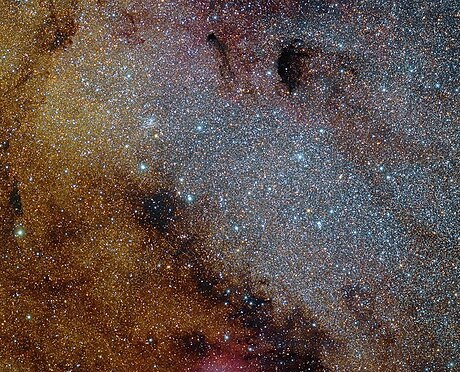The Small Sagittarius Star Cloud (also known as Messier 24 and IC 4715) is a star cloud in the constellation of Sagittarius approximately 600 light years wide, which was catalogued by Charles Messier in 1764. It should not be confused with the nearby Large Sagittarius Star Cloud which lies about 10° to the south.[4]
| Small Sagittarius Star Cloud | |
|---|---|
 Small Sagittarius Star Cloud (Messier 24) with NGC 6603 towards upper left | |
| Observation data (J2000 epoch) | |
| Right ascension | 18h 17m |
| Declination | −18° 29′ |
| Distance | ~10 kly (3070 pc) |
| Apparent magnitude (V) | 2.5[1][2] |
| Apparent dimensions (V) | 2°x1°[1] |
| Physical characteristics | |
| Radius | ~300 ly |
| Other designations | Delle Caustiche,[3] IC 4715 |
| Associations | |
| Constellation | Sagittarius |
The stars, clusters and other objects comprising M24 are part of the Sagittarius or Sagittarius-Carina arms of the Milky Way galaxy. Messier described M24 as a "large nebulosity containing many stars" and gave its dimensions as being some 1.5° across. Some sources, improperly, identify M24 as the small open cluster NGC 6603.[5] The location of the Small Sagittarius Star Cloud is near the Omega Nebula (also known as M17) and open cluster Messier 18, both north of M24. M24 is one of only three Messier objects that are not actual deep sky objects.[6]
M24 fills a space of significant volume to a depth of 10,000 to 16,000 light-years. The star cloud is the most dense concentration of individual stars visible using binoculars, with around 1,000 stars visible within a single field of view.[3] In telescopes it is best seen at low magnification, with a field of view of at least 2 degrees.[6] Described as "a virtual carpet of stellar jewels",[1] M24 is visible to the naked eye whenever the Milky Way itself is visible as well. It holds a collection of numerous types of stars that are visible through the galaxy's obscuring band of interstellar dust.[6]
The light of M24 is spread out over a large area, which makes estimating its brightness difficult. Older references give the star cloud's magnitude as 4.6, but more recent estimates place it a full two magnitudes brighter, at 2.5.[1][2]
HD 167356 is the brightest star within the Small Sagittarius Star Cloud, a white supergiant with an apparent magnitude of 6.05. This star is an Alpha-2 Canum Venaticorum variable, showing small changes in brightness as it rotates. There are three other stars in M24 with visual magnitudes between 6.5 and 7.0.[6]
The star cloud incorporates two prominent dark nebulae which are vast clouds of dense, obscuring interstellar dust. This dust blocks light from the more distant stars, which keeps them from being seen from Earth. Lying on the northwestern side is Barnard 92, which is the darker of the two. Within the star field, the nebula appears as an immense round hole devoid of stars. American astronomer Edward Emerson Barnard discovered this dark nebula in 1913.[6] Along the northeast side lies Barnard 93, as large as Barnard 92 though less obvious. There are also other dark nebulae within M24, including Barnard 304 and Barnard 307.[2][6]
The Small Sagittarius Star Cloud also contains two planetary nebulae, M 1-43 and NGC 6567. Located within a spiral arm of the Milky Way, Messier 24 holds some similarities with NGC 206, a bright, large star cloud within the Andromeda Galaxy.[6]
See also
References
External links
Wikiwand in your browser!
Seamless Wikipedia browsing. On steroids.
Every time you click a link to Wikipedia, Wiktionary or Wikiquote in your browser's search results, it will show the modern Wikiwand interface.
Wikiwand extension is a five stars, simple, with minimum permission required to keep your browsing private, safe and transparent.
